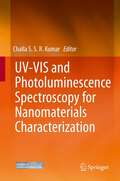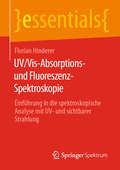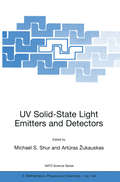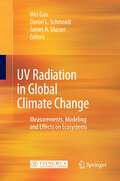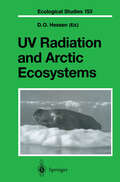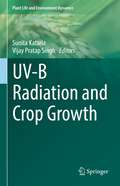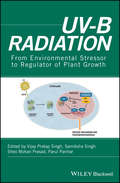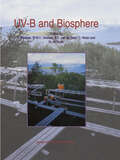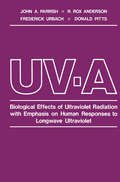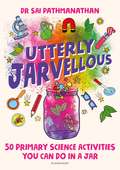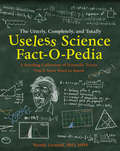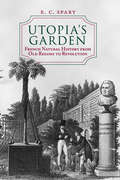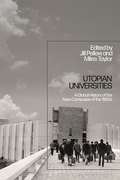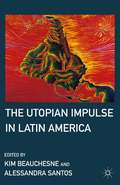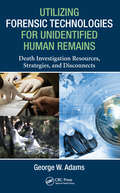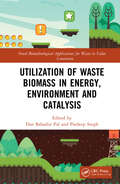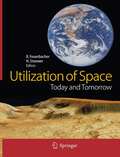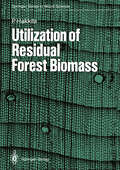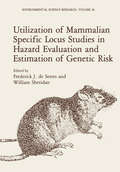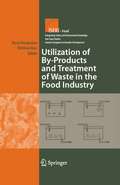- Table View
- List View
UV-VIS and Photoluminescence Spectroscopy for Nanomaterials Characterization
by Challa S. S. R. KumarSecond volume of a 40-volume series on nanoscience and nanotechnology, edited by the renowned scientist Challa S.S.R. Kumar. This handbook gives a comprehensive overview about UV-visible and photoluminescence spectroscopy for the characterization of nanomaterials. Modern applications and state-of-the-art techniques are covered and make this volume essential reading for research scientists in academia and industry in the related fields.
UV/Vis-Absorptions- und Fluoreszenz-Spektroskopie: Einführung in die spektroskopische Analyse mit UV- und sichtbarer Strahlung (essentials)
by Florian HindererFlorian Hinderer bietet in diesem essential eine leicht verständliche Einführung in Methoden der optischen Spektroskopie. Kurz und präzise, strukturiert und gut zu lesen vermittelt er die Grundlagen der UV/Vis-Absorptions- und Fluoreszenz-Spektroskopie. Vom Grundprinzip und den typischen Anwendungsgebieten der UV/Vis-Absorptions-Spektroskopie führt der Autor zu einem detaillierten Verständnis dieser Methode. Er gibt dafür einen Überblick über Grundlagen zu Auswahlregeln und zeigt die typischen Spektren organischer und anorganischer Moleküle. Ein Kapitel zu den Konzepten der Fluoreszenz-Spektroskopie sowie weiterführende Literatur runden das essential ab.
UV Solid-State Light Emitters and Detectors (NATO Science Series II: Mathematics, Physics and Chemistry #144)
by Michael S. Shur Arturas ZukauskasInfrared and visible light LEDs and photodetectors have found numerous applications and have become a truly enabling technology. The promise of solid state lighting has invigorated interest in white light LEDs. Ultraviolet LEDs and solar blind photodetectors represent the next frontier in solid state emitters and hold promise for many important applications in biology, medi cine, dentistry, solid state lighting, displays, dense data storage, and semi conductor manufacturing. One of the most important applications is in sys tems for the identification of hazardous biological agents. Compared to UV lamps, UV LEDs have lower power consumption, a longer life, compactness, and sharper spectral lines. UV LEDs can provide a variety of UV spectra and have shape and form factor flexibility and rugged ness. Using conventional phosphors, UV LEDs can generate white light with high CRI and high efficiency. If quantum cutter phosphors are developed, white light generation by UV LEDs might become even more efficient. Advances in semiconductor materials and in improved light extraction techniques led to the development of a new generation of efficient and pow erful visible high-brightness LEDs and we expect that similar improvements will be achieved in solid-state UV technology.
UV Radiation in Global Climate Change: Measurements, Modeling and Effects on Ecosystems
by Wei Gao Daniel L. Schmoldt James R. SlusserNumerous studies report that ultraviolet (UV) radiation is harmful to living organisms and detrimental to human health. Growing concerns regarding the increased levels of UV-B radiation that reach the earth's surface have led to the development of ground- and space-based measurement programs. Further study is needed on the measurement, modeling, and effects of UV radiation. The chapters of this book describe the research conducted across the globe over the past three decades in the areas of: (1) current and predicted levels of UV radiation and its associated impact on ecosystems and human health, as well as economic and social implications; (2) new developments in UV instrumentation, advances in calibration (ground- and satellite-based), measurement methods, modeling efforts, and their applications; and (3) the effects of global climate change on UV radiation. Dr. Wei Gao is a Senior Research Scientist and the Director of the USDA UV-B Monitoring and Research Program, Natural Resource Ecology Laboratory, Colorado State University. Dr. Gao is a SPIE fellow and serves as the Editor-in-Chief for the Journal of Applied Remote Sensing. Dr. Daniel L. Schmoldt is the National Program Leader for instrumentation and sensors at the National Institute of Food and Agriculture (NIFA) of the U.S. Department of Agriculture. Dr. Schmoldt served as joint Editor-in-Chief of the journal, Computers & Electronics in Agriculture, from 1997 to 2004. Dr. James R. Slusser retired in 2007 from the USDA UV-B Monitoring and Research Program at Colorado State University. He was active in the Society of Photo-Optical Instrumentation Engineers, the American Geophysical Union, and the American Meteorological Society. Dr. Slusser is currently pursuing his interests in solar energy and atmospheric transmission.
UV Radiation and Arctic Ecosystems (Ecological Studies #153)
by Prof. Dr.Although there are some biological processes that are supported by UV radiation, most organisms are stressed by it in various ways, e.g. through DNA damage.Top international experts present an integrated overview of UV radiation and its effects on terrestrial, freshwater and marine Arctic biota. Increased stratospheric ozone depletion and the corresponding increase in ground levels of UV radiation as well as ambient, "natural" UV radiation as a key ecological factor in the Arctic spring and summer are discussed in detail. Additionally, basic information on Arctic ecosystems is given. The volume provides not only an excellent account of present-day knowledge of the subject, but also describes the state of the art on which future research can be built.
UV-B Radiation and Crop Growth (Plant Life and Environment Dynamics)
by Sunita Kataria Vijay Pratap SinghThis book is an inclusive collection of topics on research on UVB for its impact on plants with a focus on its use as an emerging technology for crop growth and protection. This book covers role of UV-B on biological systems, and its transformation from generic stressor to specific regulator. It also explores the past research in UVB studies and the changing mind-sets regarding UV-B in recent time with respect to the plant growth. It also explores the discovery of specific UV-B photoreceptor, UVR8 and UVR8 mediated plants responses. This book is of interest to teachers, researchers, agriculture scientists and plant physiologists. Also the book serves as additional reading material for undergraduate and graduate students of agriculture, forestry, ecology, soil science, and environmental sciences
UV-B Radiation: From Environmental Stressor to Regulator of Plant Growth
by Vijay Pratap Singh Samiksha Singh Sheo Mohan Prasad Parul PariharUltraviolet-B (UV-B) is electromagnetic radiation coming from the sun, with a medium wavelength which is mostly absorbed by the ozone layer. The biological effects of UV-B are greater than simple heating effects, and many practical applications of UV-B radiation derive from its interactions with organic molecules. It is considered particularly harmful to the environment and living things, but what have scientific studies actually shown? UV-B Radiation: From Environmental Stressor to Regulator of Plant Growth presents a comprehensive overview of the origins, current state, and future horizons of scientific research on ultraviolet-B radiation and its perception in plants. Chapters explore all facets of UV-B research, including the basics of how UV-B's shorter wavelength radiation from the sun reaches the Earth's surface, along with its impact on the environment's biotic components and on human biological systems. Chapters also address the dramatic shift in UV-B research in recent years, reflecting emerging technologies, showing how historic research which focused exclusively on the harmful environmental effects of UV-B radiation has now given way to studies on potential benefits to humans. Topics include: UV-B and its climatology UV-B and terrestrial ecosystems Plant responses to UV-B stress UB- B avoidance mechanisms UV-B and production of secondary metabolites Discovery of UVR8 Timely and important, UV-B Radiation: From Environmental Stressor to Regulator of Plant Growth is an invaluable resource for environmentalists, researchers and students who are into the state-of-the-art research being done on exposure to UV-B radiation.
UV-B Radiation: From Environmental Stressor to Regulator of Plant Growth
by Vijay Pratap Singh Samiksha Singh Sheo Mohan Prasad Parul PariharUltraviolet-B (UV-B) is electromagnetic radiation coming from the sun, with a medium wavelength which is mostly absorbed by the ozone layer. The biological effects of UV-B are greater than simple heating effects, and many practical applications of UV-B radiation derive from its interactions with organic molecules. It is considered particularly harmful to the environment and living things, but what have scientific studies actually shown? UV-B Radiation: From Environmental Stressor to Regulator of Plant Growth presents a comprehensive overview of the origins, current state, and future horizons of scientific research on ultraviolet-B radiation and its perception in plants. Chapters explore all facets of UV-B research, including the basics of how UV-B's shorter wavelength radiation from the sun reaches the Earth's surface, along with its impact on the environment's biotic components and on human biological systems. Chapters also address the dramatic shift in UV-B research in recent years, reflecting emerging technologies, showing how historic research which focused exclusively on the harmful environmental effects of UV-B radiation has now given way to studies on potential benefits to humans. Topics include: UV-B and its climatology UV-B and terrestrial ecosystems Plant responses to UV-B stress UB- B avoidance mechanisms UV-B and production of secondary metabolites Discovery of UVR8 Timely and important, UV-B Radiation: From Environmental Stressor to Regulator of Plant Growth is an invaluable resource for environmentalists, researchers and students who are into the state-of-the-art research being done on exposure to UV-B radiation.
UV-B and Biosphere (Advances in Vegetation Science #17)
by Jelte Rozema W. W. C. Gieskes S. C. Van De Geijn C. Nolan H. De BooisCurrent phase-out schedules of the production and emission of CFC's indicate that chlorine loading in the stratosphere is not yet at its maximum. The recovery of stratospheric ozone is estimated to take time and ele vated levels of UV-B radiation are expected to occur throughout most of the next century. Despite numerous physiological studies of UV-B effects on plants, often grown in climate chambers, knowledge of UV-B effects on organisms and processes in natural aquatic or terrestrial ecosystems is poor. Currently it appears that UV-B radiation is not just an environmental stress' factor to plants. In various ways, which are incompletely understood, UV-B affects a wide range of physiological and ecological processes. Remarkably, recent field studies indicate that enhanced UV-B does not markedly affect photosynthesis, growth and primary production, but rather interferes with plant morphogenesis and plant and ecosystem functions relating to the secondary metabolism. This special issue and book UV-B and Biosphere is an attempt to cover this range and to report the progress made in the research of ecological effects of enhanced solar UV-B radiation. The papers in this book formed the basis of an international workshop entitled' UV-B and Biosphere' , December 15-18, 1995, in Wageningen, The Netherlands. A first reaction of Hans de Boois on the number of papers and sessions scheduled from Friday to Sunday morning was: far too many.
UV-A: Biological Effects of Ultraviolet Radiation with Emphasis on Human Responses to Longwave Ultraviolet
by John ParrishThe origin of this text was a request by industry and government to summarize the biological effects and to estimate the limits of safe exposure to longwave ul traviolet radiation. The specific issue was the safety of a small medium-pressure mercury arc designed to emit UV-A (NUVA-Lite, L. D. Caulk Co. , Milford, Delaware) for photopolymerization of resinous fillings used in dentistry. How- ever, the context grew to become a consideration of the risks and benefits to hu mans of electromagnetic radiation between the biologically active short UV and the visible spectrum. We have accumulated data from our own experimental work and from the literature and have attempted to put this information in the perspective of known biologic effects of ultraviolet radiation as it influences hu mans. Interest in the biological effects of longwave ultraviolet radiation is increas ing in all of the many scientific disciplines that make up the complex field of photobiology. In order to minimize the chance for error and personal prejudice and to maximize the use of expertise, each chapter has been reviewed by several authorities. Some of the contributions of this group led to significant alterations and creative additions to the chapter, and these persons deserve not only our sin cere gratitude but also recognition by the reader. These include Chapters 2 and 3: Dr. Robert E. Levin, Mr. Charles P. Comeau, Mr. Donald Gonser, Dr. David Sliney; Chapter 5: Dr. Jerry Williams, Dr. Robert Webb, Dr. Madhu A.
Utterly Jarvellous: 50 primary science activities you can do in a jar
by Dr Sai PathmanathanForget plastic beakers and pipettes, the only apparatus you need for these unique science lessons is a single household object – a jar! With 50 fun, accessible and sustainable lesson ideas covering the entire Key Stage 2 National Curriculum for science, this book will inspire teachers and engage children of all abilities. The whole class will be mesmerised by experiments to simulate a solar eclipse, build a wormery, make a lava lamp and watch a volcano erupt – all in a jar.Aimed at eliminating the need for single-use plastic, the activities in this book only require glass jars, lids and additional everyday materials that are readily available in most primary schools. Each science experiment is accompanied by a clear explanation of the science behind it, photocopiable worksheets with illustrated, step-by-step instructions for pupils to follow and evaluation questions to consolidate learning. From science specialists to those just getting to grips with the subject, all teachers can deliver these environmentally friendly, inclusive and cost-effective activities with minimal preparation.Please note that the PDF eBook version of this book cannot be printed or saved in any other format. It is intended for use on interactive whiteboards and projectors only.
The Utterly, Completely, and Totally Useless Science Fact-o-pedia: A Startling Collection Of Scientific Trivia You'll Never Need To Know
by Wendy Leonard, PhD MPHCalling all trivia buffs! Loaded with over 200 entries and almost 2,000 bits of trivia, this book will arm you with hundreds of useless scientific tidbits – perfect for curious minds.
Utopia's Garden: French Natural History from Old Regime to Revolution
by E. C. SparyThe royal Parisian botanical garden, the Jardin du Roi, was a jewel in the crown of the French Old Regime, praised by both rulers and scientific practitioners. Yet unlike many such institutions, the Jardin not only survived the French Revolution but by 1800 had become the world's leading public establishment of natural history: the Muséum d'Histoire Naturelle. E. C. Spary traces the scientific, administrative, and political strategies that enabled the foundation of the Muséum, arguing that agriculture and animal breeding rank alongside classification and collections in explaining why natural history was important for French rulers. But the Muséum's success was also a consequence of its employees' Revolutionary rhetoric: by displaying the natural order, they suggested, the institution could assist in fashioning a self-educating, self-policing Republican people. Natural history was presented as an indispensable source of national prosperity and individual virtue. Spary's fascinating account opens a new chapter in the history of France, science, and the Enlightenment.
Utopia's Garden: French Natural History from Old Regime to Revolution
by E. C. SparyThe royal Parisian botanical garden, the Jardin du Roi, was a jewel in the crown of the French Old Regime, praised by both rulers and scientific practitioners. Yet unlike many such institutions, the Jardin not only survived the French Revolution but by 1800 had become the world's leading public establishment of natural history: the Muséum d'Histoire Naturelle. E. C. Spary traces the scientific, administrative, and political strategies that enabled the foundation of the Muséum, arguing that agriculture and animal breeding rank alongside classification and collections in explaining why natural history was important for French rulers. But the Muséum's success was also a consequence of its employees' Revolutionary rhetoric: by displaying the natural order, they suggested, the institution could assist in fashioning a self-educating, self-policing Republican people. Natural history was presented as an indispensable source of national prosperity and individual virtue. Spary's fascinating account opens a new chapter in the history of France, science, and the Enlightenment.
Utopia's Garden: French Natural History from Old Regime to Revolution
by E. C. SparyThe royal Parisian botanical garden, the Jardin du Roi, was a jewel in the crown of the French Old Regime, praised by both rulers and scientific practitioners. Yet unlike many such institutions, the Jardin not only survived the French Revolution but by 1800 had become the world's leading public establishment of natural history: the Muséum d'Histoire Naturelle. E. C. Spary traces the scientific, administrative, and political strategies that enabled the foundation of the Muséum, arguing that agriculture and animal breeding rank alongside classification and collections in explaining why natural history was important for French rulers. But the Muséum's success was also a consequence of its employees' Revolutionary rhetoric: by displaying the natural order, they suggested, the institution could assist in fashioning a self-educating, self-policing Republican people. Natural history was presented as an indispensable source of national prosperity and individual virtue. Spary's fascinating account opens a new chapter in the history of France, science, and the Enlightenment.
Utopian Universities: A Global History of the New Campuses of the 1960s
by Jill Pellew and Miles TaylorIn a remarkable decade of public investment in higher education, some 200 new university campuses were established worldwide between 1961 and 1970. This volume offers a comparative and connective global history of these institutions, illustrating how their establishment, intellectual output and pedagogical experimentation sheds light on the social and cultural typography of the long 1960s. With an impressive geographic coverage - using case studies from Europe, the Americas, Africa and Asia - the book explores how these universities have influenced academic disciplines and pioneered new types of teaching, architectural design and student experience. From educational reform in West Germany to the establishment of new institutions with progressivist, interdisciplinary curricula in the Commonwealth, the illuminating case studies of this volume demonstrate how these universities shared in a common cause: the embodiment of 'utopian' ideals of living, learning and governance. At a time when the role of higher education is fiercely debated, Utopian Universities is a timely and considered intervention that offers a wide-ranging, historical dimension to contemporary predicaments.
Utopian Universities: A Global History of the New Campuses of the 1960s
In a remarkable decade of public investment in higher education, some 200 new university campuses were established worldwide between 1961 and 1970. This volume offers a comparative and connective global history of these institutions, illustrating how their establishment, intellectual output and pedagogical experimentation sheds light on the social and cultural typography of the long 1960s. With an impressive geographic coverage - using case studies from Europe, the Americas, Africa and Asia - the book explores how these universities have influenced academic disciplines and pioneered new types of teaching, architectural design and student experience. From educational reform in West Germany to the establishment of new institutions with progressivist, interdisciplinary curricula in the Commonwealth, the illuminating case studies of this volume demonstrate how these universities shared in a common cause: the embodiment of 'utopian' ideals of living, learning and governance. At a time when the role of higher education is fiercely debated, Utopian Universities is a timely and considered intervention that offers a wide-ranging, historical dimension to contemporary predicaments.
The Utopian Impulse in Latin America
by Kim Beauchesne and Alessandra SantosAn exploration of the concept of utopia in Latin America from the earliest accounts of the New World to current cultural production, the carefully selected essays in this volume represent the latest research on the topic by some of the most important Latin Americanists working in North American academia today.
Utilizing Forensic Technologies for Unidentified Human Remains: Death Investigation Resources, Strategies, and Disconnects
by George W. AdamsIn missing and unidentified investigations, an abyss of dissonance seems to exist between law enforcement and the community they serve that all too often creates grating wounds that may never heal. Utilizing Forensic Technologies for Unidentified Human Remains: Death Investigation Resources, Strategies, and Disconnects bridges this abyss.This is th
Utilization of Waste Biomass in Energy, Environment and Catalysis (Novel Biotechnological Applications for Waste to Value Conversion)
by Dan Bahadur PalBiomass finds its application as feedstock to produce biofuels and other value-added products, which finds usage in energy and environmental areas with particular focus on bioenergy production from different biomass and high-volume, medium-value industrial products. This book investigates problems of controlled synthesis of these materials and the effect of their morphological, physical, and chemical characteristics on their adsorption or desorption capacity and recent progress in green catalysts derived from biomass for various catalytic applications. Socioeconomic impacts on environment and climate regarding waste biomass are discussed as well. Features Covers recent progress on green catalysts derived from biomass Explores the biomass conversion to different resources Introduces the utilization of biowaste in environmental aspects Discusses the biomass applications in different types of energy Proposes microbial waste biomass as a resource of renewable energy This book is aimed at professionals and senior undergraduate students in environmental sciences, energy studies, and environmental and chemical engineering.
Utilization of Waste Biomass in Energy, Environment and Catalysis (Novel Biotechnological Applications for Waste to Value Conversion)
by Dan Bahadur Pal Pardeep SinghBiomass finds its application as feedstock to produce biofuels and other value-added products, which finds usage in energy and environmental areas with particular focus on bioenergy production from different biomass and high-volume, medium-value industrial products. This book investigates problems of controlled synthesis of these materials and the effect of their morphological, physical, and chemical characteristics on their adsorption or desorption capacity and recent progress in green catalysts derived from biomass for various catalytic applications. Socioeconomic impacts on environment and climate regarding waste biomass are discussed as well. Features Covers recent progress on green catalysts derived from biomass Explores the biomass conversion to different resources Introduces the utilization of biowaste in environmental aspects Discusses the biomass applications in different types of energy Proposes microbial waste biomass as a resource of renewable energy This book is aimed at professionals and senior undergraduate students in environmental sciences, energy studies, and environmental and chemical engineering.
Utilization of Space: Today and Tomorrow
by Berndt Feuerbacher Heinz StoewerDescribes the various fields of application of astronautics and the underlying technology. Written on a level understandable for non-specialists. Provides an outlook on the future of this fascinating field.
Utilization of Residual Forest Biomass (Springer Series in Wood Science)
by Pentti HakkilaAn increase in the demand for wood results in improved recovery and less residual biomass in the forests. Paradoxically, interest in forest residue as a renewable source of raw material seems to be in a reverse ratio to its availability in a certain area. Finland and Sweden are probably more dependent on forestry and forest in dustries than any other developed countries in the world. A sufficiency of raw ma terial for integrated forest industries is vital for the national economy of both countries, and a great deal of attention is being paid to the long-term potential of unutilized biomass left behind in logging operations. Furthermore, since these countries possess no reserves of fossil fuels, and since their per-capita consump tion of primary energy is exceptionally high, they also consider unmerchantable forest biomass a realistic source of indigenous energy. A joint Nordic research project on harvesting and utilization of logging residue was carried out in 1969-1976 under the auspices of the Nordic Research Council on Forest Operations. This fruitful cooperation soon gave rise to related national projects in Sweden, Finland, Norway, and Denmark, stimulating further research and producing practical applications. Concurrently, particularly after the worldwide energy crisis in 1973, research on all aspects of utilization of forest bio mass mushroomed in the United States, Canada, and the Soviet Union. An ex plosive increase occurred in both the number and diversity of biomass studies.
Utilization of Mammalian Specific Locus Studies in Hazard Evaluation and Estimation of Genetic Risk (Environmental Science Research #28)
by F.J. De SerresThe magnitude of the threat to the human genetic material posed by environmental agents has not as yet been fully determined. Never theless, the potential hazards of many chemicals have been identi fied by studies on lower organisms. However, too little is known regarding the comparability or lack of it between the metabolic pathways available in such organisms and those in man. Although at present there is great public concern for what is considered by some as the excessive use of laboratory animals in toxicological testing, it seems clear that the usage of mammalian systems may be deemed necessary. It has been proposed that cell culture systems might suffice to meet this need, however, such approaches cannot match the complexity of physiological occurances that are present in the intact animal. For studies of genetic effects, some non-invasive human test systems are presently available. These do not, however, meet the re quirements for extensive laboratory studies. In order to assess the risks to humans of environmental factors such laboratory investiga tions are essential. Therefore, for the forseeable future reliance on experiments using laboratory animals will be necessary. This Volume, which contains the proceedings of a workshop which was held at the National Institute of Environmental Health Sciences, March 29-31, 1982, explores the existing methodologies and their utility for risk estimations. It covers the most well developed human systems, as well as the most widely used animal tests.
Utilization of By-Products and Treatment of Waste in the Food Industry (Integrating Food Science and Engineering Knowledge Into the Food Chain #3)
by Vasso Oreopoulou Winfried RussThis is the third volume of the ISEKI-Food book series. It deals with the main features of utilization of the food industry waste, defined thereby as by-product, and the treatments necessary to discard waste to environmental acceptors. It discusses the utilization of byproducts of plants and fish, and presents case studies on waste treatment in the food industry.
